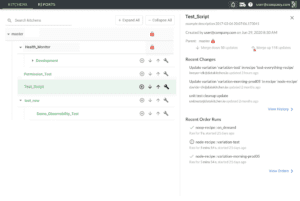Navigating the Storm: How Data Engineering Teams Can Overcome a Data Quality Crisis
Ah, the data quality crisis. It’s that moment when your carefully crafted data pipelines start spewing out numbers that make as much sense as a cat trying to bark. You know you’re in trouble when the finance team uses your reports as modern art installations rather than decision-making tools. But fear not, fellow data wranglers! We’ve all been there; there’s a way out of this crisis of lousy data.
Let’s face it: data problems are rarely just about the data. They’re like onions (or ogres, if you’re a Shrek fan) – they have layers. At the core, we often deal with collaboration hiccups and process potholes. It’s like trying to bake a cake when half the team thinks we’re making sushi, and the other half juggles the eggs. We’ve got siloed expertise that would make medieval castle builders proud, documentation so sparse it could win a minimalist art competition, and a reliance on “data heroes” that would make Marvel envious. Add a dash of unreliable source data, a pinch of outdated infrastructure, and a sprinkle of architectural challenges, and voila! You’ve got yourself a recipe for data disaster.
Data quality issues rarely exist in isolation. They are often symptomatic of broader organizational challenges that require a holistic approach. Let’s delve into some of the root causes:
- Collaboration and Process Issues: Data problems are frequently the result of inadequate collaboration and flawed processes. Teams working in silos, poor communication channels, and a lack of standardized procedures can lead to inconsistencies and errors in data handling.
- Knowledge Gaps: A lack of comprehensive understanding of the data being handled and the business context it serves can lead to misinterpretations and incorrect data processing. This knowledge deficit can stem from insufficient training, high turnover rates, or poor knowledge transfer practices.
- Siloed Expertise and Hero Dependency: When knowledge is concentrated among a few individuals rather than distributed across the team, it creates a risky dependency. Poor documentation exacerbates this issue, making it difficult for new team members to get up to speed or for others to fill in during absences.
- Time Constraints: Teams often prioritize immediate deliverables over long-term quality improvements in fast-paced environments. This lack of time for collaboration and learning can lead to shortcuts that compromise data quality.
- Absence of a Data Quality Framework: Without a structured approach to ensuring data quality, teams lack clear guidelines for best practices and actionable steps to address issues when they arise.
- Unreliable Source Data: Inconsistent or poor-quality input data creates issues throughout the data pipeline. Addressing this often requires collaboration with data providers or upstream systems.
- Inadequate Infrastructure: Outdated or insufficient server and software infrastructure can lead to performance issues, data loss, and inconsistencies. Resolving this problem often requires significant investment.
- Architectural Limitations: Data and process architectures that are outdated, inadequate, or fail to scale with growing data volumes can become a significant bottleneck, leading to quality issues and inefficiencies.
- Recurring Process Failures: Insufficient testing, nonexistent observability, reliance on manual processes, and code management issues (such as lack of version control) can result in frequent errors and inconsistencies.
- Downstream Data Consumption Issues: Poor communication about data characteristics, inflexible data structures, or overly permissive access can lead to downstream consumers’ misuse or misinterpretation of data.
The symptoms of this crisis can feel like a bad case of data indigestion. Suddenly, you’re playing a game of “Where’s Waldo?” with your process flows, your error rates are higher than a kite on a windy day, and trust in your data evaporates faster than spilled coffee on a hot sidewalk. Before you know it, you’re caught in a downward spiral that makes roller coasters look tame. The blame game becomes the new office sport, with fingers pointing in so many directions you could use them as a compass. Pressure mounts heroic all-nighters become the norm, and suddenly, your team starts eyeing the exit door like it’s the last lifeboat on the Titanic.
Recognizing the signs of a data quality crisis is crucial for timely intervention. Here are the key indicators:
- The Downward Spiral: Deteriorating data quality creates a negative feedback loop. Poor data leads to mistrust, leading to workarounds and degrading data quality.
- Poor Visibility: Lack of transparency in data flows and processes makes it difficult to identify the source of problems or implement effective solutions.
- Frequent Process Failures: Recurring issues in data processing, often requiring manual intervention, are a clear sign of underlying problems.
- Elevated Error Rates: An increase in the frequency and severity of data errors is a red flag that should not be ignored.
- Consumer-Detected Errors: When data consumers identify errors, it indicates a failure in internal quality control measures.
- Loss of Trust: As errors persist, stakeholders lose confidence in the data and the team responsible for it.
- The Blame Game: When problems arise, finger-pointing between teams or departments often ensues, hindering collaborative problem-solving.
- Pressure and Burnout: The constant need for firefighting increases pressure on the team, often resulting in unsustainable heroic efforts that lead to burnout and turnover. War Rooms Suck.
But don’t panic! It’s time for some rapid intervention, and no, that doesn’t mean hiring a data exorcist (though, at this point, you might be tempted). Start by forming a cross-functional “Quality Circle” team – think of it as your data A-Team, minus the van and mohawks. Gather intel on your current issues, such as planning a heist, but instead of stealing diamonds, you’re after those elusive root causes. Prioritize your problems and hunt for quick wins – they’re like data-quality comfort food, giving you a momentary respite and a chance to catch your breath. Use tools like the trusty fishbone diagram or a riveting game of “5 Whys” (it’s like 20 Questions, but for data nerds). The goal here is to fix something – anything! – to show that there’s light at the end of this very messy tunnel.
When facing a data quality crisis, immediate action is crucial. Here’s a step-by-step approach to rapid intervention:
- Form a Cross-Functional Quality Circle: Assemble a team that includes representatives from data engineering, business units, and downstream data consumers. This diverse group will provide a comprehensive perspective on the issues at hand.
- Gather Data on Current Issues: Conduct a thorough assessment of ongoing data quality problems. Use quantitative metrics where possible and gather qualitative feedback from data users.
- Prioritize High-Impact Problems: Not all issues can be addressed simultaneously. Focus on the problems that have the most significant impact on business operations or decision-making.
- Identify Quick Wins: Look for issues that can be resolved quickly with minimal resources. These early successes will build momentum and demonstrate progress to stakeholders.
- Conduct Quick Root-Cause Analysis: Use techniques like Fishbone diagrams, 5-Why analysis, and issue walkthroughs to identify the underlying causes of priority issues quickly.
- Brainstorm and Implement Quick Fixes: Generate ideas for short-term solutions that can mitigate the most pressing problems. Implement these quickly, but be sure to document them for future reference.
- Maintain Regular Meetings and Feedback Loops: Continue to meet regularly as a Quality Circle, seeking feedback on implemented solutions and identifying new issues as they arise.
- These rapid intervention steps can yield several immediate benefits: You demonstrate the team’s capability and commitment to quality by fixing a few issues. The process helps all stakeholders gain insight into the challenges and complexities of data management. Working together on urgent problems can break down silos and foster better relationships between teams. By focusing on solutions rather than fault-finding, teams can move past the blame game and work constructively.
As you emerge from the immediate fire-fighting phase, blinking in the sunlight of slightly less terrible data quality, it’s time to think long-term. This is where you channel your inner data quality guru and build consensus for sustainable solutions. Dive deep into your data collection practices like Jacques Cousteau exploring the ocean depths. Conduct root-cause analysis with the tenacity of a terrier chasing a squirrel. Develop more sustainable solutions than your colleague’s New Year’s resolutions and more scalable than your grandma’s cookie recipe. Remember, the journey to data quality nirvana is a marathon, not a sprint. By taking steady steps towards DataOps maturity and continuous improvement, you’ll not only survive this crisis but come out the other side with a data engineering team that’s more robust, more collaborative, and wiser. And who knows? The next time a data quality crisis looms, you might say, “It’s an opportunity for improvement” rather than an “opportunity to blame.”
While rapid intervention provides immediate relief, using this momentum to drive long-term, sustainable improvements is crucial. Here’s how:
- Improve DataOps Maturity: Implement DataOps practices that emphasize collaboration, automation, and continuous improvement in data management.
- Deep-dive into Data Collection and Measurement: Conduct a thorough analysis of how data is collected, processed, and measured throughout its lifecycle.
- Extended Root-Cause Analysis: Build on the quick analysis done during rapid intervention to investigate systemic issues comprehensively.
- Develop Sustainable Solutions: Design and implement scalable, maintainable, and aligned with long-term business goals.
- Implement Long-term Action Plans: Create detailed plans for improving data quality over time, including milestones and success metrics.
- Institute Good Monitoring and Observability Practices: Implement robust monitoring tools and practices to catch issues early and provide visibility into data processes.
- Establish Continuous Improvement: Create a culture and processes that support ongoing refinement and enhancement of data quality practices.
- Take Simple Steps to Show Value: Implement easy-to-adopt DataOps practices that demonstrate immediate value, such as those outlined in the article “4 Easy Ways to Start DataOps Today.”
A data quality crisis can be pivotal for a data engineering team. While challenging, it presents an opportunity to reassess, realign, and rebuild stronger data management practices. By combining rapid intervention techniques with a commitment to long-term improvements, teams can resolve the immediate crisis and establish a foundation for sustained data quality excellence.
Navigating a data quality crisis requires a calm, empathetic, and systematic approach. By addressing immediate issues through rapid intervention and building consensus for long-term solutions, we can transform a crisis into an opportunity for growth and improvement. Remember, every data quality crisis is a chance to strengthen the foundations of our data processes and build a more resilient, reliable data ecosystem. So, let’s steer this ship together, with confidence and a sense of humor, towards calmer waters.







